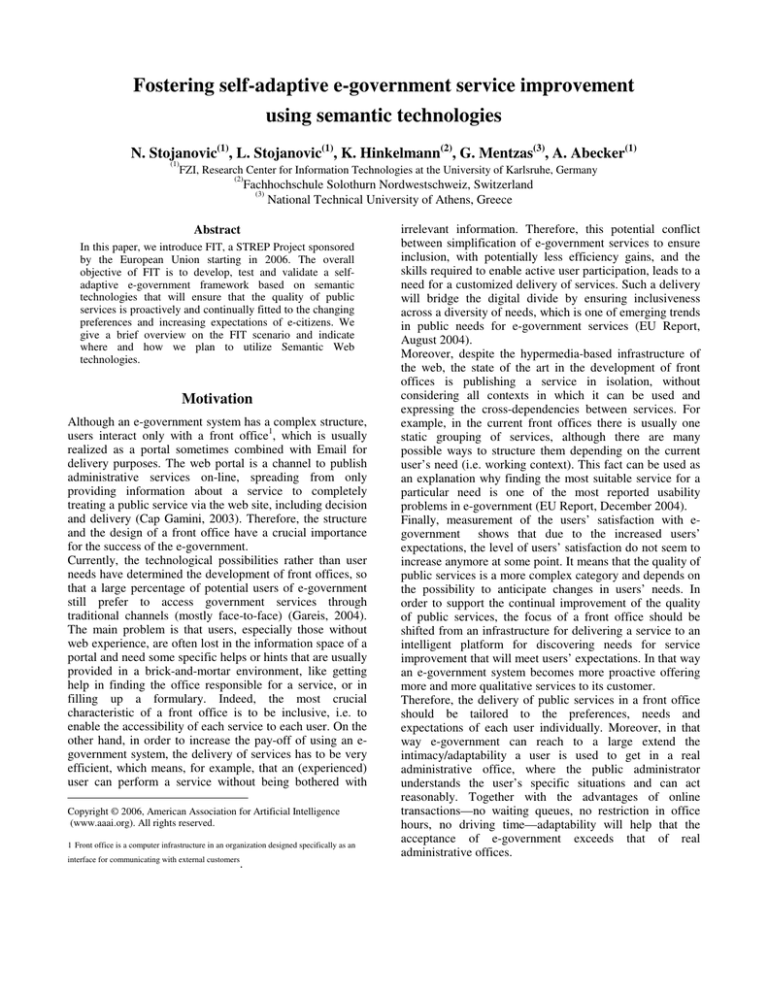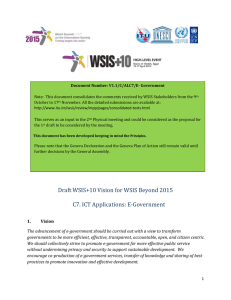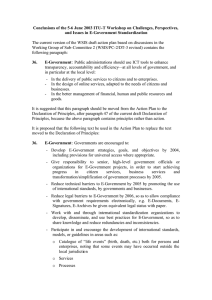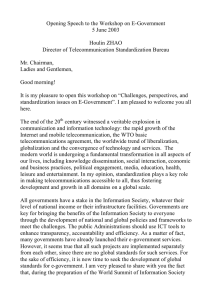
Fostering self-adaptive e-government service improvement
using semantic technologies
N. Stojanovic(1), L. Stojanovic(1), K. Hinkelmann(2), G. Mentzas(3), A. Abecker(1)
(1)
FZI, Research Center for Information Technologies at the University of Karlsruhe, Germany
(2)
Fachhochschule Solothurn Nordwestschweiz, Switzerland
(3)
National Technical University of Athens, Greece
Abstract
In this paper, we introduce FIT, a STREP Project sponsored
by the European Union starting in 2006. The overall
objective of FIT is to develop, test and validate a selfadaptive e-government framework based on semantic
technologies that will ensure that the quality of public
services is proactively and continually fitted to the changing
preferences and increasing expectations of e-citizens. We
give a brief overview on the FIT scenario and indicate
where and how we plan to utilize Semantic Web
technologies.
Motivation
Although an e-government system has a complex structure,
users interact only with a front office1, which is usually
realized as a portal sometimes combined with Email for
delivery purposes. The web portal is a channel to publish
administrative services on-line, spreading from only
providing information about a service to completely
treating a public service via the web site, including decision
and delivery (Cap Gamini, 2003). Therefore, the structure
and the design of a front office have a crucial importance
for the success of the e-government.
Currently, the technological possibilities rather than user
needs have determined the development of front offices, so
that a large percentage of potential users of e-government
still prefer to access government services through
traditional channels (mostly face-to-face) (Gareis, 2004).
The main problem is that users, especially those without
web experience, are often lost in the information space of a
portal and need some specific helps or hints that are usually
provided in a brick-and-mortar environment, like getting
help in finding the office responsible for a service, or in
filling up a formulary. Indeed, the most crucial
characteristic of a front office is to be inclusive, i.e. to
enable the accessibility of each service to each user. On the
other hand, in order to increase the pay-off of using an egovernment system, the delivery of services has to be very
efficient, which means, for example, that an (experienced)
user can perform a service without being bothered with
Copyright © 2006, American Association for Artificial Intelligence
(www.aaai.org). All rights reserved.
1 Front office is a computer infrastructure in an organization designed specifically as an
interface for communicating with external customers
.
irrelevant information. Therefore, this potential conflict
between simplification of e-government services to ensure
inclusion, with potentially less efficiency gains, and the
skills required to enable active user participation, leads to a
need for a customized delivery of services. Such a delivery
will bridge the digital divide by ensuring inclusiveness
across a diversity of needs, which is one of emerging trends
in public needs for e-government services (EU Report,
August 2004).
Moreover, despite the hypermedia-based infrastructure of
the web, the state of the art in the development of front
offices is publishing a service in isolation, without
considering all contexts in which it can be used and
expressing the cross-dependencies between services. For
example, in the current front offices there is usually one
static grouping of services, although there are many
possible ways to structure them depending on the current
user’s need (i.e. working context). This fact can be used as
an explanation why finding the most suitable service for a
particular need is one of the most reported usability
problems in e-government (EU Report, December 2004).
Finally, measurement of the users’ satisfaction with egovernment shows that due to the increased users’
expectations, the level of users’ satisfaction do not seem to
increase anymore at some point. It means that the quality of
public services is a more complex category and depends on
the possibility to anticipate changes in users’ needs. In
order to support the continual improvement of the quality
of public services, the focus of a front office should be
shifted from an infrastructure for delivering a service to an
intelligent platform for discovering needs for service
improvement that will meet users’ expectations. In that way
an e-government system becomes more proactive offering
more and more qualitative services to its customer.
Therefore, the delivery of public services in a front office
should be tailored to the preferences, needs and
expectations of each user individually. Moreover, in that
way e-government can reach to a large extend the
intimacy/adaptability a user is used to get in a real
administrative office, where the public administrator
understands the user’s specific situations and can act
reasonably. Together with the advantages of online
transactions—no waiting queues, no restriction in office
hours, no driving time—adaptability will help that the
acceptance of e-government exceeds that of real
administrative offices.
In this paper we introduce the FIT (Fostering self-adaptive
e-government service Improvement using semantic
Technologies) project that will specify, develop and deploy
a holistic framework and supporting tools for an inclusive
and personalized e-government, by enabling continual
adaptation of the services to the changing needs and
preferences of users, through the application of the
semantic technologies. Moreover, it will lay a foundation
of a self-adaptive e-government, which automatically
discovers deficiencies in its functioning and fits itself in
order to satisfy ever increasing users’ expectations.
serving users between e-government portals. In that way
FIT addresses three of four key challenges defined for the
e-government in the EU in the next decade (EU Report,
August 2004), namely knowledge-based, user-centered and
networked e-government.
FIT approach
There are two challenges in realizing an adaptive front
office. First, experience shows that web users tend to be
reluctant to provide the feedback about their
satisfaction/expectations via filling questionnaires or forms.
In order to avoid asking users explicitly, means for
capturing their preferences implicitly are required. Second,
many of the current generation of public services are offline services converted for on-line use without further
development and optimization of the services. It means that
the description of public services must be extended with the
information about users’ preferences in order to enable
their customized delivery. This makes the customization
process more difficult since the changes in the back office
are required as well.
Figure 1 illustrates the above presented problems in the
existing e-government systems and how FIT will address
these problems. More specifically, FIT intends to provide:
- a personalized front office (instead of a uniform one)
that will enable personalized and „inclusive for all“ access,
regarding users’ preferences, needs and expectations;
- a quality-driven bidirectional platform (instead of one
way service delivery) that will enable context-aware
delivery of services and implicit capturing of users’
feedbacks about the usability of the front office;
- a customized back office (instead of an inflexible one)
that will ensure multi-context views (shown as a new
dimension in “To-Be” situation in Figure 1) on public
services based on the user and quality model;
- a framework to support knowledge sharing between front
offices, i.e. how to use best practices learned in one front
office in other offices.
Note that the fourth issue is not explicitly shown in Figure
1, since it goes beyond the customization of a front office,
enabling the customization of a community of them.
Resolving all these issues leads to the realization of a selfadaptive e-government system, i.e. a system that
incorporates mechanisms to assess how a service is
performing based on different criteria, and then enables to
take action to optimize it. Indeed, it helps to find the “weak
places” in a service delivery regarding the users’ needs,
ensures that generated recommendations reflect the users'
needs, and promotes the accountability of a government.
Moreover, this approach lays a foundation for a
collaborative platform for exchanging experience in
Figure 1: As-Is vs. To-Be situation
FIT Scenario
Since the goal of FIT is to create self-adaptive egovernment, we will adapt autonomic computing initiative.
FIT will be realized according to the ontology-based
MAPE (Monitor Analyze Plan Execute) model
(Stojanovic, et al., 2004), which uses ontologies as the
backbone of the adaptation process. The approach abstracts
the management architecture into four common functions:
collect data, analyze data, create a plan of action, and
execute the plan. Indeed, the conceptual framework
decomposes the control loop into four parts:
- Monitor – mechanism that collects, organizes and filters
the data about users’ interactions with the e-government
portal;
- Analyze – mechanism that aggregates and transforms the
collected data, correlates this data with background
knowledge (e.g. domain knowledge, quality model, user
model, administrative processes) and makes proposals for
improvement;
- Plan – mechanism to structure actions needed to realize
requests for improvement by modifying the underlying
administrative process description. The planning
mechanism uses “learned” business rules to guide the work;
- Execute – mechanism to update the portal according to
the changes applied in the business process descriptions
and the needs of users.
By monitoring (M) the behavior of users and analyzing (A)
this data, planning (P) which actions should be taken and
executing (E) them, a kind of a “usage loop” is created.
Figure 2 depicts this “usage loop”. A user is searching for
an on-line service by querying and/or navigating through an
e-government portal (cf. 1 in Figure 2). All activities that
the citizen performs are acquired in the Semantic Log (cf.
2), which is structured according to the Log Ontology, and
contains meta-information about the content of visited
pages whose meaning is represented in the Domain
ontology. This log data is analyzed in the Knowledge
Discovery module (cf. 3) that detects anomalies in the
design of a portal and/or on-line services, whose repairing
improves the usability of this portal. The context
information (described through Quality ontology, User
ontology, Administrative processes ontology) is used to
improve the learning. This discovered knowledge is incorporated in the existing administrative processes, through
business rules (cf. 4) in order to be interpreted by a workflow engine. Finally, since the underlying portal provides a
view on on-line administrative processes, all changes made
in the processes are reflected on the portal (cf. 1), by
tailoring the portal to the users’ needs, which implicitly
arose. The repetition of this cycle leads to the continual
improvement of an e-government system.
FIT
Ontology
E-Users
Request
Response
„customize workflow execution:
us
If the user is from this group,
ag
e
se in Then present more information
E rvice on-li
s ne
Front-office
e.g.
„problems in
filling-up a
form“
ut r
bo viou
a a eha M
t
da ‘ b
s
er
us
Semantic
Logging 2
1
Domain
ontology
Quality
model
Start
Star t
Process1
Pr oc ess1
Start
i
e nf
e- nri orm
go ch a A
ve ed tio
co rn w n
nt em ith
ex e
t nt
“problems in filling-up a form in the
process of issuing a driving license
for foreigners, by some users”
User
model
Proc ess2
Proc ess2
Proc ess1
Process3
Proc ess3
Process
Improvement
4
En d
End
Process2
Proc ess3
En d
Administrative processes
Back -office
Knowledge
Discovery
ge ‘
P led sers s
ow u ce
3
kn out ren
ab refe
p „there is a group of users (with
low language skills) which need
more information about the
issuing licences“
Figure 2: Closing the Semantic Loop in using an egovernment system: The conceptual architecture of FIT
according to the MAPE model
For example, if many citizens spent a lot of time on filling
in a form of a service or they cannot finish the
corresponding activity, then the Knowledge Discovery
module will learn preference rules for such groups of users
(e.g. which additional content should be shown in order to
make the process more efficient). For a new user, the
system will discover, by analyzing the clicks the user made
in the current web session, which group of e-citizens he/she
could belong to. Consequently, the execution of e-services
will be customized according to already learned preference
rules and the user will be able to finish a task efficiently.
Similarly, more advanced users will profit from the
customization by not being “bored” with information,
which is useless for them. In that way, FIT aims to be a
user-friendly platform that integrates the results from the
analysis of the usage data with the tools that guide the
process of modifying the portal.
FIT Ontology
In order to enable formal specification and analysis of the
adaptation process all factors that influence the adaptation
as well as the relationships between them should be defined
formally and explicitly. This formal model will be captured
in the FIT ontology. In order to develop it, the following
available information will be used:
- Website structure - The way that the website is
physically laid out can be useful toward understanding
usage behavior and interpreting system suggestions. The
semantic information about the reasons why the structure
exists in the way that it does may also inform the system.
- Website content - The content of web pages themselves
is essential toward determining particular topical interests
and understanding the relationships between pages.
- Website usage data - The most important data set is the
recording of interactions of users with the website, in other
words, the way that the website is used.
- User data - Information about the people using the
system can help in understanding their interests, or in
finding common groups of users which share interests.
The explicit representation of the semantics of all relevant
data through the FIT ontology will enable e-government to
provide a qualitatively new level of functionalities. For
example, the gap analysis that will enable the discovery of
problems (deficiency) in the e-government portal in case
that no service is found for a given user’s request.
The FIT ontology will play a role of an e-government
upper ontology, by ensuring that there is “one model in one
place” and that the e-government is “decentralized but
connectable”. In that way the FIT ontology can be used as a
basis for the federated navigation and inference.
Finally, the FIT ontology will be combined with
information about the “usage” of some entities from the egovernment domain, which will support the discovery of
frequently used resources as well as unused resources that
might indicate the existence of a problematic situation. This
will lead to the development of a proactive e-government
that uses predictive methods to drive its adaptation.
Acknowledgement
The research presented in this paper was partially funded
by the EC in the project “IST PROJECT 27090 - FIT”.
References
Cap Gamini Ernst&Young’s, 2003, Online availability of
public services, http://europa.eu.int/information_society/
eeurope/2005/doc/highlights/whats_new/capgemini4.pdf
Gareis, K., 2004, Towards User-centred e-government –
Understanding Demand for Online Public Services,
TeleCities conference “Urban Impacts of the Information
Society: Facts, Fiction and Policies”, The Hague.
EU Report (August 2004), 2004, e-government in the EU
in the next decade: the vision and key challenges,
Technical Report EUR 21376 EN
EU report (December 2004), 2004, User Satisfaction and
Usage
Survey
of
e-government
services,
http://europa.eu.int/information_society/activities/egovern
ment_research/doc/top_of_the_web_report_2004.pdf
Stojanovic, L., et al., 2004, The Role of Ontologies in
Autonomic Computing Systems, IBM Systems Journal,
Vol. 43 (No. 3)









